It's a doggy dog world... in this episode we're talking pugs, bulldogs, and French bulldogs. They've all been bred for flat faces, but their airways haven't shrunk alongside their skulls - meaning that they often struggle to breathe. How has this happened? After evolving for millions of years, why are their airways literally too big to fit into their heads? Have they been betrayed by their own genes? Naked Genetics is on the case. Plus, the origin of puppy dog eyes, and we sequence the genome of Bruce the black lab puppy...
In this episode
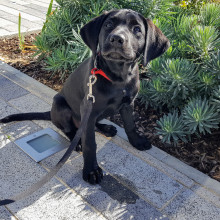
01:13 - Will It Sequence: Bruce!
Will It Sequence: Bruce!
Ursula Arndt, Illumina
Dogs are hugely diverse. They can be as big as great danes or as small as chihuahuas. Their fur can be brown, white, or even dark blue, and they can be anywhere on the spectrum of short-haired to massive fluffball. What's going on inside their cells that gives them such a range of shapes and sizes? We went to gene sequencing company Illumina to find out. In this first edition of Will It Sequence, we're trying to decode the genome of Bruce the black lab puppy.
Ursula - Hello this is Ursula Arndt, I’m a scientist at Illumina. And what's your name?
Amelia - I’m Amelia and I own Bruce, the young puppy we’ve got here.
Ursula - Excellent, so Bruce… obviously an incredibly adorable black Labrador puppy. We’re going to take DNA from the inside of its mouth. And what we have is a swab. So we’re going to see if we can get him to keep it in his mouth and we’re going to rub it around his cheek for a couple of minutes.
Amelia - What are you picking up from inside of the mouth with that swab?
Ursula - Mostly saliva, but what we should be getting is a lot of dog cells as well. And what we're hoping for actually, that we’re not just getting dog, but we might be getting some of the bacteria that might be in his mouth as well.
Amelia - And what will you do with those?
Ursula - Sequence them on one of our sequencers, and then we can tell you a lot more about Bruce.
Amelia - Bruce!
Ursula - Bruce! Nom nom nom. So right now I'm trying to swab the inside of his cheek and not just his teeth, without him eating the entire tube. And right now he’s really trying to chew on my hand as well. Okay, I think we’re good Bruce. So I’ve now turned the swab around, and so the piece that looks like a Q-tip is now inside of the liquid, and that’s gonna take the DNA from the swab and hopefully preserve it.
Amelia - And what happens next?
Ursula - So tomorrow morning we’re gonna take this liquid that contains his cells. We’re gonna break up the cell, and we’re gonna keep the DNA and throw away everything that's protein or that’s cell parts, cell walls, everything that's not DNA. We’re gonna sequence all of his genome and then we’re gonna, actually, our biostaticians are going to look at how much wolf is in the dog, I think that's one of our main questions. Then we see what else we can find.
Amelia - How big is the DNA code of a dog?
Ursula - I think it's essentially the same size as human, almost.
Amelia - How long will it take to sequence the DNA of him?
Ursula - So we plan to do the DNA extraction, and then the library - we call it library prep, that makes the DNA ready for sequencing - we’re gonna take just under a day, and then the sequencing is going to take a day and a half. OK, so we’re gonna take a couple of hair samples now. I know you’re really... OK. OK, so I’m trying to get the dog to not wiggle, because I don’t want to cut him while he's moving. But I’m gonna take some hair just from the back of his neck. Can you hold on to your dog for me? Yeah, that should be plenty of hair here. That should be more than enough dog in this tube. Thank you so much Bruce!
Amelia - Bruce? Bruce? Biscuit?
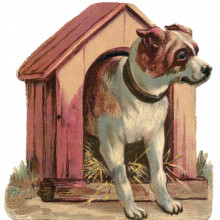
04:43 - Breeding and breathing
Breeding and breathing
James Serpell, University of Pennsylvania
Where do dogs come from? By looking at their DNA, scientists can tell that they’re most closely related to wolves. They evolved thousands of years ago when humans domesticated them. And we bred them intensively, because we relied on them to protect our livestock and stop us from starving. Normally evolution on this scale takes millions of years - but here it had tens of thousands. And this was only a warm-up act. In the 19th Century, the real dog breeding began. Phil Sansom spoke to James Serpell, professor of animal ethics and welfare at the University of Pennsylvania...
James - In the 1850s, Victorians started to focus on dogs as a kind of a hobby breeding species, and you've got the creation of something called the ‘dog fancy’. Prior to the 1850s, there were lots of different breeds, or more correctly landraces of dogs out there; people took these local varieties and then genetically isolated them from the rest of the population and started breeding like-to-like. They created studbooks so that they knew exactly who had been bred to whom. That in itself creates problems because you've got such a limited pool of genes to draw upon in the first place, and you also get things like inbreeding depression occurring, and founder effects, and genetic drift, and so on.
Phil - Can you explain what you mean by this inbreeding depression, and founder effects, and all these things?
James - Well, founder effects is essentially just the result of starting with a very small initial population. So instead of having a wide diversity of genes contributing to your population, you're selecting from a very small number to begin with. Genetic drift is when just through random processes, a dog dying or a dog disappearing from the population... because you've got such a small initial founding population, that tends to make that genetic pool drift in peculiar directions. And inbreeding, the sort of things that happen then are… if you've got a deleterious gene in the population, usually that will be masked by more dominant genes that are healthy. But if you start doing a lot of inbreeding you can mess that up and what you get is the expression of these deleterious genes. And those deleterious genes could be something that reduces fertility, that increases predisposition to cancer, all kinds of possible things can go on. So yes it was bad news for the genetics of the animals. And people actually recognised the dangers very early on even before anybody knew anything about genetics.
Phil - Has that led to consequences for dogs today?
James - Yes! So for many breeds they are quite inbred. The other fact has been that they wrote down what they called the Breed Standard, which is a verbal description of the breed. And sometimes these Breed Standards are kind of absurd when you look at them in practical terms. So in the English bulldog, for example, the Standard says that the distance between the tip of the nose and the forehead, essentially, should be a short as possible. So obviously if you’re a bulldog breeder or a bulldog judge at a dog show, what you're looking for is an animal that has a very short distance between the nose and the forehead or no distance at all, and in fact that's sort of what has happened to the bulldog’s head. The nose has been pushed backwards until it is in fact flush with the front of the dog’s head, and as a result, most bulldogs have difficulty breathing and many will require surgery to correct this problem. Now I'm sure it was never in anybody’s design to produce an animal that can’t breathe. But if the Breed Standard said that there should be minimal distance between the tip of the nose and the forehead, then that’s what the breeders and the judges were aiming for. And they've succeeded horribly. And this is not just in reference to the dog's head, it's a problem now with the fact that many of these brachycephalic breeds, like the bulldog, the ones with the squashed faces, can't actually breed properly. The puppies have to be born by caesarean section. And this is also a product of breeding for a very large head size in relation to hip size. It's unsafe now for the female dogs to give birth naturally. Clearly when you get to that sort of point, something has gone horribly wrong with the process.
Phil - It seems like the flat-faced dogs are really good examples of the worst of this kind of thing. So why is it that the breeding standard has said that they should have such short faces, and that we’ve bred them like this?
James - The research that’s being done so far suggests that people find this look very very appealing. To some people these dogs look kind of infantile, look like human infants, and they find them irresistibly cute, irresistibly appealing. In the last ten years, a lot of these breeds have shown a massive increase in popularity across Europe and the United States, things like French bulldogs, pugs, English bulldogs, they became super popular breeds.
Phil - Are these dogs suffering?
James - Absolutely, without a doubt. And they may suffer for their entire life. The problem with these dogs is they can't breathe, you know, if you try and exercise them too much they will collapse. They have severe respiratory problems, they have all kinds of skin fold problems, their eyes bulge out and tend to get injured because you know, they’ll crash into a branch or an object on the ground and scratch the cornea of the eye. Many of these dogs will have to have surgery to correct the breathing problems. They’re going to develop other health problems during their lifetimes that’s going to cost the owners money and a lot of grief, they're probably going to die young. Normally if something we’re doing to animals is causing this level of suffering we would have laws and rules that would restrict that type of behaviour. But because these are pets and they live as members of our family, somehow we don't think of them in quite the same way. But I think a lot of it is just ignorance and public blindness to the problems that have been created, they don't really see it for what it is.
Phil - Can I ask, do you own a dog?
James - I do yes.
Phil - What kind of dog?
James - It’s a sort of average mutt-looking, shaggy haired, black dog, medium size, very nice temperament. We call him a Bosnian Snakehound. This is a joke, he did once meet a snake and he chased it into a hole. That is probably the most exciting thing he's ever encountered.
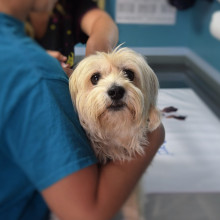
11:39 - A gene for flat faces?
A gene for flat faces?
Jeff Schoenebeck, Roslin Institute
The dog genome has been under a lot of pressure. Thanks to 150 years of breeding, the genetic variation within a single breed of dogs is really small. So for someone trying to uncover the genes behind brachycephaly, this presents both an opportunity and a challenge. Jeff Schoenebeck is that person. He told Phil Sansom how his lab at the Roslin Institute in Edinburgh uses CT scans of dogs from a nearby animal hospital...
Jeff - We take that data, we generate 3D reconstructions, and so it gives us a very quantitative description of the dog’s overall size, the length of its face, the roundness of its brain case… when there’s leftover bloods, we call them residuals, when we have owner consent we’re able to use these blood samples to extract DNA. So if we have the metrics and then we have the DNA of a dog, then we can begin building this population dataset. And so we want to understand: what are the genetics of reducing face length; and then we want to know, are there certain changes that are more responsible for this airway condition that afflicts these dogs?
Phil - If there are, they’re tricky to find. Because each breed is so related to each other, any gene they all share might code for anything from shorter faces to stumpier legs to curlier tails. And so the challenge is to separate out all these factors - and you can’t do that if you just have data from purebred bulldogs, for example.
Jeff - We're collecting data from dogs that are mixed breed as well, or dogs that maybe have a slightly shorter face but not nearly as dramatic as our bulldog. And so by utilising that mixed genetic ancestry we can help pinpoint the genetic changes that we believe are relevant to morphology, and that aren't necessarily related to some other commonality.
Phil - So if the mixed breeds with shorter faces all share a certain gene with the pugs, then you might be onto something. It’s just a matter of finding that gene.
Jeff - At its heart, what we're trying to do is we're looking across each dog’s genome at markers. And these markers are just simple genetic differences.
Phil - Specifically, a genetic marker is a certain point on a certain chromosome that you use to compare the dogs. And the point is by using a bunch of those, you can narrow in on the right place to start looking in more detail. How does that work? Well, let’s say you pick a single point as your marker, halfway down chromosome number one. The molecule at that point could be any of the four building blocks of DNA: A, C, G, or T. Let's say one dog has an A at that point, and another has a C. That’s all fine. And maybe a short faced dogs is equally likely to have an A there as a long-faced dog. But what if way more of the short-faced dogs actually have a C there? That’s a hint - maybe that part of chromosome 1 is important for short faces. You’d say that the marker is segregating according to face length. And you know what - that’s exactly what Jeff and his team found.
Jeff - It was not just one marker, it was a bunch of markers within the same region, and as geneticists we like that. And indeed, the one difference that we discovered on chromosome 1 is that there's this bit of DNA that jumped into the middle of a gene. Now, it didn't jump into the portion of the gene that encodes a protein, but nonetheless it jumped in the middle of the gene and caused the gene to malfunction if you will. The gene product wasn’t made correctly. And this gene is known to have a role in skeletal development and it's a very good candidate for being the major contributor to reducing face length.
Phil - The gene is called SMOC2. Jeff’s team are sure it’s a major player. Pugs, bulldogs, and French bulldogs all have two copies of it. But to date, there are at least two other genes that have also been found to affect a dog’s face length. So turns out it’s not that simple. SMOC2 isn’t exactly “the face length gene”.
Jeff - We describe face length reduction in dogs as being a complex genetic trait, meaning it's not just one gene, but rather it's a bunch of genes working together and depending on what kind of flavour of that gene an individual has will determine where along a continuum of face length it will reside.
Phil - And then face length is only part of the picture. Jeff and his team are also specifically looking into the breathing problem, brachycephalic obstructive airway syndrome. And they started looking in a breed you wouldn’t expect - Norwich terriers.
Jeff - They're not flat faced in the way that you think of a bulldog or a pug, but yet a certain portion of these dogs were suffering from a condition labeled "upper airway syndrome". So how can this be? The question was how could we reconcile this? Is this a condition that is simply specific to Norwich terriers, and it just kind of masquerades in a way that resembles what's occurring in bulldogs and these other breeds; or is it that it's brachycephalic obstructive airway syndrom? Maybe it's not all about face shape.
Phil - They think they’ve found a mutation that causes this "upper airway syndrome" - a problem with a gene called ADAMTS3. ADAMTS3 seems to affect the fluid in the airways, and get this - both bulldogs and French bulldogs have the same broken version of ADAMTS3.
Jeff - And as far as we know it doesn’t have anything to do with skull shape. So that observation suggests there’s the possibility that there are some things that can be selected against that may help improve their breeding without necessarily changing their skull shape.
Phil - But if it might be possible to breed out this ADAMTS3 variation, could you just do the same for the other genes the team have found? Like that one SMOC2?
Jeff - They can't breed out the SMOC2 gene in bulldogs because as far as we know, every bulldog has 2 copies of the genetic insertion that we discovered. So there is no other bulldog that doesn't carry it at least as far as we know. Even if there was, it would be such a small segment of the overall population of bulldogs that to breed just that one group of dogs would be disastrous. It would cause almost a collapse in genetic diversity in a breed who's arguably already at risk of being too homogenous on a genetic level. Probably the best way to go about reducing the effects of these problematic flavors of genes is to outcross, to bring in another dog and isn't specifically a bulldog, that doesn't have this very, very short face, to breed away from the extreme short face that exists currently. It's a viewpoint that I acknowledg, is highly controversial, but that is one way. So there isn't going to be one silver magic... magic silver bullet for for all these dogs.

CRUFFA and change
Jemima Harrison, CRUFFA
We’ve been talking about some of the genetic issues purebred dogs face, particularly flat-faced dogs like bulldogs and pugs. What does the future hold? Someone who’s neck deep in these issues is Jemima Harrison. She’s a journalist and a campaigner who founded an organisation called CRUFFA - the campaign for responsible use of flat-faced animals. She told Phil Sansom about her mission...
Jemima - Although the Kennel Club is doing a whole heap more than it used to, the shape of these dogs is still codified in the Kennel Club Breed Standard - which demands flat faces, round, big eyes... it self-perpetuates really, because the Breed Standard demands that the dogs look like this, despite very small tweaks in those Breed Standards. So now rather than saying ‘very short’ it might say ‘fairly short’. But all these phrases are pretty meaningless when you're dealing with a culture of breeders that have always done it a particular way. Anything that has been crossed to another breed to bring in health or more moderate features is seen as a mongrel. That perception needs to be addressed.
Phil - What is it that makes you personally so passionate about this?
Jemima - Well I've always been completely dog-mad. But in 2001 my dog died, my dog Freddie. And Freddie was a flat coated retriever, a breed that is really compromised genetically because it's a small breed and has been extremely inbred. There isn't any individual that is less inbred than a full sibling - sorry, half sibling I should say, to any other flat coat. And it was after he died that I discovered that the breed was completely beset by cancer, and a particular type of soft tissue sarcoma. 50% of flat coats will be dead by the age of eight/nine from some form of cancer. And it was inevitably... I mean, it didn't really take anybody with any nous to be able to suss out that it was because of inbreeding, and because of a feature called ‘popular sires’ where if a male dog wins big in the show ring, everybody wants to have its babies. So of course that causes havoc genetically, because you are reducing the gene pool with every generation. It just horrified me that people were just accepting it. I had a breeder turn round to me and say, “oh you have to love them a lot because you don't have them for long.” And I felt like strangling her, because I just felt, it doesn't have to be like that! We're really smart. I mean, what breeders do is incredible, it’s just that if they were able to turn around how they saw things, that would be something incredible. And so I'm hoping that in my lifetime I will see some real change that would make me incredibly happy. I mean, I am... someone once said to me a, flatmate years ago in London, I said to a flat girl, “well of course I've always been half dog.” And they said to me, “hmm, I don't think there's that much human in you.”
Phil - What's your ideal world then, out of all of this?
Jemima - Oh, goodness. A world where we appreciate that a dog is a dog and not a baby. That it deserves functional eyes, a respiratory system that works, a body that can mate and give birth naturally... I want dogs to be dogs.
Phil - If you had a pug or an English bulldog or a French bulldog breeder in front of you - or an owner - what would you tell them?
Jemima - We've got to do better by these dogs. The dogs love us absolutely, unequivocally, unjudgmentally, and we are doing them such a disservice in return. So I would beg anybody who's got a brachycephalic dog now to love them to bits, but never get another one.
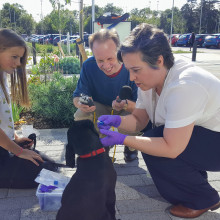
The Results: Bruce's Genome
Julian Gehring and Ursula Arndt, Illumina
Machines have been whirring and computers have been computing to sequence the genes of Bruce the black lab puppy. Now his results are in. Our correspondent Amelia Smith went back to meet Illumina scientists Julian Gehring and Ursula Arndt. What secrets do Bruce's DNA hold?
Julian - Bruce's genome is like a massive book, like several copies of the Harry Potter series in a way. But what we get out of the sequencer are like very short fragments of the text, like individual words or fragments of a sentence. Now in order to analyse that what we try to do is put the text together, in a way.
Amelia - So you basically put the book back together with all the sentences and chapters in the right place?
Julian - Exactly. That's what we do. And the way we do it is that we have a template of how an average dog genome could look like, and with this as a template we can take these individual pieces, these individual fragments, and put them all together in place. We can then look for what we call variation or alterations in the genome, which will then tell us how Bruce's genome is different from that of an average dog.
Amelia - What did this actually show you? What did you find?
Ursula - What we found is that your puppy looks like a labrador, and genetically looks a lot like a labrador as well.
Amelia - So what's the likelihood of Bruce being descended from a wolf?
Julian - He's much closer to a wolf than he is for example to a cat or a human. That's what we could see in the data. And by looking at different dog breeds we could see for example that huskies are still rather similar to wolves; then afterwards come a bit labradors, which are in the middle; and then very distinct from wolves are then dog breeds like pugs or chihuahuas or terriers.
Amelia - So what other things did you find in Bruce’s saliva?
Ursula - That's a really good question. So we were really interested in that. Most of the DNA was dog but there was a little bit of bacteria in there as well. Most of the bacteria are just normal, and we found a little bit of plant potentially, which makes sense because he's been chewing on stuff while we were sampling, right. We didn't find as much bacteria that we had kind of anticipated. Bruce is only 12 weeks old so I think his microbiome might still be developing until he's an adult, just like with human children.
Julian - I think if you look at the dataset of Bruce now and the understanding of his genome it's probably the best-sequenced dog we have at the moment. So there’s probably more interesting stuff to find in his genome. The next thing we have to do is find the cuteness gene and figure out why he looks so cute and cuddly.
Amelia - Thank you very much for doing what you've done with Bruce's DNA.
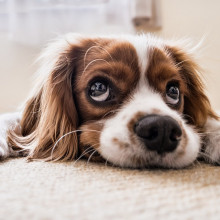
27:29 - Puppy dog eyes
Puppy dog eyes
We've sequenced the genome of Bruce the black lab puppy, but we couldn't find a gene for cuteness. Which he has in spades. Well, there might not be a cuteness gene, but zoology correspondent Lucy Cole has the story of the next-best thing.
Lucy - Have you ever thought that your dog is able to make the most adorable puppy dog eyes at exactly the right moment? Well, British and American researchers have found that dogs have in fact evolved a particular muscle in their face to allow them to do just this. It’s just above the eyebrow and it’s called the levator anguli oculi medialis. It allows dogs to lift the inner corners of their eyebrows to create those unmistakable puppy dog eyes.
In this study, the researchers dissected both dogs and wolves to compare them. It turns out that wolves don’t have this extra muscle, so it seems that dogs have developed it since being domesticated around 33,000 years ago. In fact, the team found that the Siberian husky, an ancient breed of dog more closely related to the wolf, is the only species which doesn’t have it. This means that it has taken just a few tens of thousands of years for this to evolve which, in evolutionary terms, is really quick!
We don’t yet know what genes are behind the levator anguli oculi medialis, but muscles are complex structures, and evolving a new one would probably need some big genetic changes. Why would this have happened? That’s what the next part of the study was investigating. The researchers tested how live dogs and wolves reacted when a stranger approached them. Dogs raised their eyebrows more commonly than wolves, and in a far more exaggerated way.
The theory is that using this muscle to raise their eyebrows actually helps dogs form social connections with us, and makes us want to care for them. Raising their eyebrows makes their eyes bigger and more like human children’s eyes, which elicits a caring response in us. Perhaps 33,000 years ago our ancestors were more likely to bring a dog in from the cold and protect it, if it could lift its eyebrows to look more like a human baby.
In fact, in a previous study, the same researchers found that dogs who raise their eyebrows get adopted from re-homing centres more quickly. So if being adopted gives a dog’s genes a better chance of survival, it seems that even today, dogs with more puppy-like features could have a selective advantage.
So next time you find yourself looking into those puppy dog eyes and forgiving your dog for misbehaving, just remember that it’s entirely our fault.










Comments
Add a comment